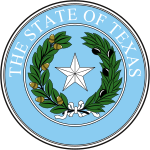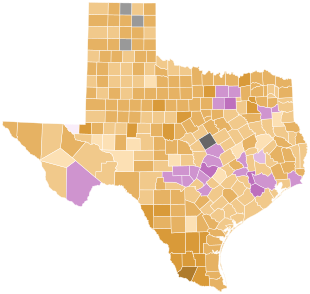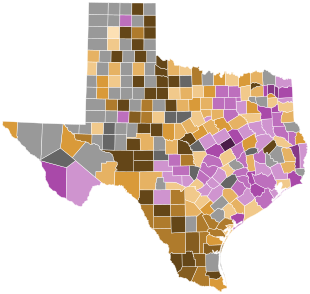| ||||||||||||||||||||||
| ||||||||||||||||||||||
Primary/caucus results by county Clinton: 40–50% 50–60% 60–70% 70–80% 80–90% 90–100% 100% Obama: 40–50% 50–60% 60–70% 70–80% 80–90% 100% Tie: Tie No results: No results | ||||||||||||||||||||||
| Elections in Texas |
|---|
 |
|
|
The 2008 Texas Democratic presidential primary and caucuses were a series of events to determine the delegates that the Texas Democratic Party sent to the 2008 Democratic National Convention. Delegates were selected using results from two sources: the Texas Presidential Primary held on March 4 by the Secretary of State of Texas's office, and a series of caucus events held between March 4 and June 7 by the Texas Democratic Party. The indecisive results of Super Tuesday, and the fact that Texas had the largest number of delegates among the states remaining on the Democratic primary calendar, resulted in the Texas primary receiving significant attention from both the Hillary Clinton and Barack Obama campaigns. [1] [2] [3] [4] [5]
Of 12,752,417 registered voters, 22.49% turned out. [6] The contest between the two candidates was very close: Senator Hillary Clinton won the primary, while her opponent, Senator Barack Obama, received more support in the caucuses. In the end, Obama secured 99 pledged delegates to Clinton's 94.
Delegate breakdown
The Texas Democratic Party sent a total of 228 delegates to the 2008 Democratic National Convention. Of those delegates, 193 were pledged and 35 were unpledged. Most of the 193 pledged delegates were allocated at the National Convention according to the results of the Texas Presidential Primary on March 4. The 35 unpledged delegates were popularly called " superdelegates" because their votes represented their personal decisions, whereas the regular delegates' votes represented the collective decision of many voters. Superdelegates were free to vote for any candidate at the National Convention and were selected by the Texas Democratic Party's officials. [7] [8]
The 193 pledged delegates were further divided into 126 district delegates and 67 statewide delegates. The 126 district delegates were divided among Texas's 31 Senatorial Districts and were allocated to the presidential candidates based on the primary results in each District. The 67 statewide delegates were divided into 42 at-large delegates and 25 Party Leaders and Elected Officials (abbreviated PLEOs). They were allocated to the presidential candidates based on the preference of the delegates at the State Convention on June 6–7. [7] [8]
Of the 35 unpledged delegates, 32 were selected in advance and 3 were selected at the State Convention. The delegates selected in advance were 17 Democratic National Committee members, the 13 Democratic U.S. Representatives from Texas, and 2 Distinguished Party Leaders: former U.S. House Speaker Jim Wright and former DNC chairman Robert Schwarz Strauss. [7] [8]
Delegate selection process
The Texas Democratic Party used a combination of two processes to select delegates and determine how they would be allocated to each presidential candidate. First, the Party used the results of the primary process to determine how 126 of its 193 pledged delegates would be allocated to each candidate. Second, the Party used the caucus process to select its precinct, county, state, and national delegates, and also to determine how many of the remaining 67 pledged delegates would be allocated to each candidate. Many states require that candidates receive at least 15% of the total votes to receive delegates. The Texas Democratic Party only applies this requirement to the primary process and the final step of the caucus process, since those are the only two occasions in which the Party allocates delegates to candidates. [7] [8]
Primary
The Texas Presidential Primary was held on March 4. It was an open primary, permitting participants to vote for candidates in any one party, regardless of voters' party affiliations. Participants were then considered as restricted to that party for the purpose of calculations regarding primaries and runoff elections for the next two years. The Primary itself was funded by the Texas State Government and administered by the Secretary of the State of Texas's office. The Texas Democratic Party used the results of the Primary to determine how its 126 district delegates would be apportioned to each presidential candidate.
Unlike other states, and even the Republican Party of Texas, the Texas Democratic Party does not allocate its delegates to Congressional Districts. Instead, it allocates its delegates to the state's 31 Senatorial Districts. The number of delegates that the Party allocates to each District depends on the votes cast in each district for the Democratic candidates during two previous general elections: Chris Bell in the 2006 Texas gubernatorial election and John Kerry in the 2004 U.S. presidential election. [7] [8] One effect of this allocation scheme is that districts with a high population of African-American residents are awarded a higher number of delegates, [9] while districts with a high population of Hispanic residents are awarded a lower number. [10] [11]
Primary polling places were open from 7:00 a.m. until 7:00 p.m. [12] In accordance with the law, any voter in line by 7:00 p.m. was permitted to vote.[ citation needed] The Texas Secretary of State had a web site that provides the location of polling places. [13] The site also offered a list of contact numbers for local county clerks and elections administrators where voters may obtain polling place location information. [14] The Texas Democratic Party's official web site also included information about the locations of polling places. [15]
Caucuses
The Texas Democratic Party holds three tiers of caucus events to select its delegates: precinct conventions, County and Senatorial District conventions, and a State Convention. The precinct conventions immediately followed the primary, a process in 2008 that was advertised as the "Texas Two-Step". [16] Senator Royce West is chair of the Advisory Committee on the Texas Democratic Party Convention/Caucus System, which is charged with investigating the caucus system, including whether to retain the Texas Two Step. [17] Former Texas Attorney general Jim Mattox testified against the Texas Two-Step at a hearing of Senator West's committee held in Austin. [18]
Precinct conventions
The precinct conventions were held beginning March 4 at 7:15 p.m. (15 minutes after the Primary polls close) or after the last person in line at 7:00 p.m. had voted. At each precinct convention, participants chose Precinct Delegates to go to the County or Senate District conventions. The Texas Democratic Party allocated one Precinct Delegate to each precinct for every 15 votes cast for Chris Bell (the party's gubernatorial candidate) in the 2006 Texas general election. [7]
Participation was open to anyone who voted in the Primary, whether they voted early, as an absentee, or on the day of the Primary. Participants had to sign in and provide proof that they voted in the Primary. Such proof could be provided in one of several ways: showing a registration card that was stamped at the Primary, producing an early voting receipt, providing an official photo identification that can be checked against a roll of early voters, or signing an affidavit (oath). Texas Democratic precinct conventions are governed by Robert's Rules of Order and Texas Democratic Party Rules. [19] Participants arriving late to the convention could still participate but could not affect any voting that had already taken place.
When the time came to select the Precinct Delegates, participants declared their candidate preference, or that they were uncommitted, which is an option not available on the primary ballot. [20] The participants in each presidential candidate preference group then chose the delegates to represent them at the County and Senate District conventions.
A total of 8,247 precinct conventions [21] [22] were held throughout the 254 counties in Texas, most of which were held at each precinct's Primary polling place.
Concerns had been raised in the media about the logistics in place for the precinct conventions in light of the unprecedented massive participation. [23] For example, in Harris County —of which Houston is the seat, and in which 874 conventions are scheduled— the highest primary turn-out in the past two decades was 78,000 in 2004, whereas 170,032 have already voted early in this year's Primary. [24] Typically about 5,000 people attend the precinct conventions held throughout Harris County; up to 100,000 were expected to participate this year. [25] In the event, there was an estimated turnout of one million throughout the state, and as of March 11 the final result of the caucuses in Harris County was unknown., [26] as party volunteers were still collecting packets from that county's 874 precincts. The Dallas Morning News reported a projected turnout of 1.1 million. [27] Overall, less than half of the precincts statewide had reported to the state Democratic party by mid-March. [28]
County and Senatorial District conventions
County and Senatorial District Conventions were held on March 29. At each convention, Precinct Delegates chose the County Delegates (7,315 in total among all the conventions) to go to the State Convention. The Texas Democratic Party allocated one County Delegate to each convention for every 180 votes cast for Chris Bell in the 2006 Texas gubernatorial election.
State Convention
The State Convention was held on June 6–7. At the Convention, the 7,315 County Delegates plus 351 state superdelegates chose 67 delegates to go to the Democratic National Convention: 42 At-large Delegates and 25 Pledged Party Leader and Elected Official (PLEO) delegates. These 67 delegates, along with the 126 district delegates, brought the total for pledged delegates to 193. [29] The delegates at the State Convention also chose 3 "add-on" unpledged delegates to attend the Democratic National Convention.
Polls
A poll of likely Democratic primary voters on March 2 showed Sen. Hillary Clinton with a statistically insignificant 50% to 49% lead, with 1% Not Sure. [30]
Results
Primary results
Primary date: March 4, 2008
National pledged delegates determined: 126 (of 193)
| Key: | Withdrew prior to contest |
| Texas Democratic presidential primary, 2008 [31] | |||
|---|---|---|---|
| Candidate | Votes | Percentage | National district delegates [8] |
| Hillary Clinton | 1,462,734 | 50.88% | 65 |
| Barack Obama | 1,362,476 | 47.39% | 61 |
| John Edwards | 29,936 | 1.04% | 0 |
| Bill Richardson | 10,773 | 0.37% | 0 |
| Joe Biden | 5,290 | 0.18% | 0 |
| Christopher Dodd | 3,777 | 0.13% | 0 |
| Totals | 2,874,986 | 100.00% | 126 |
Precinct convention results
Convention date: March 4, 2008
National pledged delegates determined: 0 (of 193)
| Texas Democratic presidential precinct conventions, 2008 41.10% of precincts reporting [32] [33] | |||
|---|---|---|---|
| Candidate | Precinct delegates | Percentage | Estimated national At-Large and PLEO delegates [8] |
| Barack Obama | 23,918 | 56.18% | 38 |
| Hillary Clinton | 18,620 | 43.73% | 29 |
| Other | 6 | 0.01% | 0 |
| Uncommitted | 38 | 0.09% | 0 |
| Undetermined | 45,492 | - | 0 |
| Totals | 88,074 | 100.00% | 67 |
Challenged results
On March 14, the Clinton campaign issued a letter to the Texas Democratic Party challenging the results of its precinct conventions. The letter proposed that the Party delay the County and Senatorial District conventions until it could provide the campaign with "presidential preference counts [that] can be made based on a review of each and every sign in sheet to determine eligibility of participants and delegates". [34] Texas Democratic Chairman Boyd Richie issued a statement on March 17 rejecting the proposal, stating that the Texas Democratic Party "will not set up an unnecessary, ad hoc 'verification' process that could effectively disqualify delegates selected at their precinct conventions after the fact." [35]
County and Senatorial District convention results
Convention date: March 29, 2008
National pledged delegates determined: 0 (of 193)
| Texas Democratic presidential County and Senatorial District conventions, 2008 89.79% of districts representing 96.60% of the delegates reporting [36] | |||
|---|---|---|---|
| Candidate | County delegates | Percentage | Estimated national At-Large and PLEO delegates [8] |
| Barack Obama | 4,039 | 54.71% | 37 |
| Hillary Clinton | 3,317 | 44.93% | 30 |
| Uncommitted | 26 | 00.35% | 0 |
| Totals | 7,382 | 100.00% | 67 |
| Undetermined | 260 | (3.40%) | - |
State Convention results
Convention date: June 6–7, 2008
National pledged delegates determined: 67 (of 193)
| Texas Democratic presidential state convention, 2008 [37] | |||
|---|---|---|---|
| Candidate | Votes | Percentage | National At-Large and PLEO delegates |
| Barack Obama | ? | 57.3% | 38 |
| Hillary Clinton | ? | 42.7% | 29 |
| Totals | 7,649 | 100% | 67 |
See also
References
- ^ Texans For Obama - Barack Obama in '08.:: There is No Such Thing as the Texas Primary Part II: Delegate Projections Archived 2008-02-19 at the Wayback Machine
- ^ Clinton-Obama primary battle a Texas toss-up | Dallas Morning News | News for Dallas, Texas | Columnist Gromer Jeffers Jr. | Dallas–Fort Worth News
- ^ Local: South Texas critical to Democratic presidential nomination | texas, delegates, clinton : Brownsville Herald
- ^ Texas Presidential Primary Round-Up: February 11, 2008 — Capitol Annex Archived March 21, 2008, at the Wayback Machine
- ^ Clinton, Obama poised to pour attention into Texas Archived 2008-02-22 at the Wayback Machine
- ^ "2008 Democratic Party Primary Election". Office of the Secretary of State. March 4, 2008. Retrieved March 7, 2008. [ dead link]
- ^ a b c d e f "Texas Delegate Selection Plan For The 2008 Democratic National Convention" (PDF). Texas Democratic Party. August 2007. Archived from the original (PDF) on March 5, 2008. Retrieved March 2, 2008.
- ^ a b c d e f g h Berg-Andersson, Richard (March 6, 2008). "Texas Democrat Presidential Nominating Process". The Green Papers. Retrieved March 8, 2008.
- ^ In Texas, black voters could be difference for Obama | Dallas Morning News | News for Dallas, Texas | Texas Politics | The Dallas Morning News
- ^ Ornstein, Norman (February 24, 2008). "Why Obama's lone star may shine". Daily News. New York.
- ^ VOA News - US Democratic Candidates Battle for Hispanic Votes in Texas Archived 2008-02-26 at the Wayback Machine
- ^ "Frequently Asked Questions". Texas Secretary of State. Archived from the original on March 5, 2008. Retrieved March 4, 2008.
- ^ "Finding My Polling Place". Texas Secretary of State. Archived from the original on March 5, 2008. Retrieved March 4, 2008.
- ^ "Election Duties". Texas Secretary of State. Retrieved March 4, 2008.
- ^ "Primary Election Polling Locations". Texas Democratic Party. Archived from the original on March 5, 2008. Retrieved March 4, 2008.
- ^ A guide to Texas' electoral two-step | Chron.com - Houston Chronicle
- ^ Democratic advisory group reviews 'Texas Two-Step' voting system | dallaswnews.com - Dallas Morning News
- ^ "Video of Jim Mattox Testifying Against the Texas Two-Step at Austin Hearing on November 14". Archived from the original on December 1, 2008. Retrieved December 17, 2008.
- ^ "Precinct Convention Procedures". Archived from the original on March 6, 2008. Retrieved March 4, 2008.
- ^ "March presidential primaries in Texas set stage for selection of national party convention delegates" (PDF). Interim News. House Research Organization, Texas House of Representatives. January 24, 2008. No 80-2. Archived from the original (PDF) on February 22, 2008.
- ^ "2008 Democratic Party Primary Election". Office of the Secretary of State. March 4, 2008. Retrieved March 6, 2008. [ dead link]
- ^ January 2008 Voter Registration Figures
- ^ https://news.yahoo.com/s/ap/20080229/ap_on_el_pr/texas_primary_and_caucus [ dead link]
- ^ Harris County Democratic Party - Welcome!
- ^ A guide to Texas' electoral two-step | Chron.com - Houston Chronicle
- ^ Harris County Dems have yet to start caucus tally | Chron.com - Houston Chronicle
- ^ "Unexpected turnout seen as big factor in Texas Democratic caucus complaints". The Dallas Morning News. March 6, 2008.
- ^ Victoria Advocate - Democrats still counting caucus results
- ^ "How To Be a Delegate to the 2008 Democratic National Convention" (PDF). Texas Democrats. Archived from the original (PDF) on March 12, 2008. Retrieved February 16, 2008.
- ^ "Texas Democratic Presidential Primary". Rasmussenreports.com. March 2, 2008. Archived from the original on February 26, 2008. Retrieved March 3, 2008.
- ^ "2008 Democratic Party Primary Election". Office of the Secretary of State. March 4, 2008. Archived from the original on January 9, 2014. Retrieved May 19, 2008.
- ^ "Unofficial Results: Texas Democratic Party Precinct Conventions". Texas Democratic Party. March 30, 2008. Archived from the original on March 6, 2008. Retrieved March 30, 2008.
- ^ "Election Center 2008". CNN. Retrieved April 9, 2008.
- ^ Musselman, Karl-Thomas (March 16, 2008). "Clinton's Letter to the TDP Seeking to Delay County Conventions". Burnt Orange Report. Archived from the original on March 20, 2008. Retrieved March 17, 2008.
- ^ "Texas Democratic Party Will Not Grant Clinton Request". KXAN-TV. March 17, 2008. Retrieved March 17, 2008.[ permanent dead link]
- ^ "BOR Exclusive: TX Presidential Primary Convention Results". March 29, 2008. Archived from the original on April 1, 2008. Retrieved March 30, 2008. (County-by-county breakdown link, less superdelegates)
- ^ Dallas Morning News | News for Dallas, Texas | Texas/Southwest
External links
- Texas Secretary of State information about the Texas Presidential Primary
- Texas Democratic Party information about Texas Democratic caucus events
- [1] List of National Delegates, Alternates and Standing Committee members elected 6/7/08 at Texas State Dem. Convention
- Group of Texas Democrats Seeking to End the Texas Two Step



